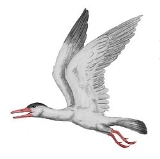
Mooreville Chalk Formation
Encyclopedia
The Mooreville Chalk Formation is a geological formation in North America
, within the U.S.
states of Alabama
and Mississippi
. The strata date back to the early Santonian
to the early Campanian
stage of the Late Cretaceous
. The chalk
was formed by pelagic sediments
deposited along the eastern edge of the Mississippi embayment
. It is a unit of the Selma Group
and consists of the upper Arcola Limestone Member and an unnamed lower member. Dinosaur
, mosasaur
, and primitive bird
remains are among the fossils that have been recovered from the Mooreville Chalk Formation.
North America
North America is a continent wholly within the Northern Hemisphere and almost wholly within the Western Hemisphere. It is also considered a northern subcontinent of the Americas...
, within the U.S.
United States
The United States of America is a federal constitutional republic comprising fifty states and a federal district...
states of Alabama
Alabama
Alabama is a state located in the southeastern region of the United States. It is bordered by Tennessee to the north, Georgia to the east, Florida and the Gulf of Mexico to the south, and Mississippi to the west. Alabama ranks 30th in total land area and ranks second in the size of its inland...
and Mississippi
Mississippi
Mississippi is a U.S. state located in the Southern United States. Jackson is the state capital and largest city. The name of the state derives from the Mississippi River, which flows along its western boundary, whose name comes from the Ojibwe word misi-ziibi...
. The strata date back to the early Santonian
Santonian
The Santonian is an age in the geologic timescale or a chronostratigraphic stage. It is a subdivision of the Late Cretaceous epoch or Upper Cretaceous series. It spans the time between 85.8 ± 0.7 mya and 83.5 ± 0.7 mya...
to the early Campanian
Campanian
The Campanian is, in the ICS' geologic timescale, the fifth of six ages of the Late Cretaceous epoch . The Campanian spans the time from 83.5 ± 0.7 Ma to 70.6 ± 0.6 Ma ...
stage of the Late Cretaceous
Late Cretaceous
The Late Cretaceous is the younger of two epochs into which the Cretaceous period is divided in the geologic timescale. Rock strata from this epoch form the Upper Cretaceous series...
. The chalk
Chalk
Chalk is a soft, white, porous sedimentary rock, a form of limestone composed of the mineral calcite. Calcite is calcium carbonate or CaCO3. It forms under reasonably deep marine conditions from the gradual accumulation of minute calcite plates shed from micro-organisms called coccolithophores....
was formed by pelagic sediments
Pelagic sediments
Pelagic sediment or pelagite is a fine-grained sediment that has accumulated by the settling of particles through the water column to the ocean floor beneath the open ocean far from land. These particles consist primarily of either the microscopic, calcareous or siliceous shells of phytoplankton or...
deposited along the eastern edge of the Mississippi embayment
Mississippi embayment
The Mississippi Embayment is a physiographic feature in the south-central United States, part of the Mississippi Alluvial Plain. It is essentially a northward continuation of the fluvial sediments of the Mississippi River Delta to its confluence with the Ohio River at Cairo, Illinois. The embayment...
. It is a unit of the Selma Group
Selma Group
The Selma Group is a geological formation in North America, within the U.S. states of Alabama, Mississippi, and Tennessee. The strata date from the Santonian to the Maastrichtian stages of the Late Cretaceous. The group is composed of, in ascending order, the Mooreville Chalk Formation, Demopolis...
and consists of the upper Arcola Limestone Member and an unnamed lower member. Dinosaur
Dinosaur
Dinosaurs are a diverse group of animals of the clade and superorder Dinosauria. They were the dominant terrestrial vertebrates for over 160 million years, from the late Triassic period until the end of the Cretaceous , when the Cretaceous–Paleogene extinction event led to the extinction of...
, mosasaur
Mosasaur
Mosasaurs are large extinct marine lizards. The first fossil remains were discovered in a limestone quarry at Maastricht on the Meuse in 1764...
, and primitive bird
Bird
Birds are feathered, winged, bipedal, endothermic , egg-laying, vertebrate animals. Around 10,000 living species and 188 families makes them the most speciose class of tetrapod vertebrates. They inhabit ecosystems across the globe, from the Arctic to the Antarctic. Extant birds range in size from...
remains are among the fossils that have been recovered from the Mooreville Chalk Formation.
Cartilaginous fish
| Cartilaginous fish of the Mooreville Chalk Formation | ||||||
|---|---|---|---|---|---|---|
| Genus | Species | Location | Stratigraphic position | Abundance | Notes | Images |
Cretalamna |
C. appendiculata |
A lamniform Lamniformes Lamniformes is an order of sharks commonly known as mackerel sharks . It includes some of the most familiar species of sharks, such as the great white shark, as well as more unusual representatives, such as the goblin shark and the megamouth shark.Members of the order are distinguished by... |
 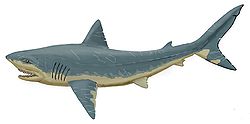 |
|||
Cretoxyrhina |
C. mantelli |
A lamniform Lamniformes Lamniformes is an order of sharks commonly known as mackerel sharks . It includes some of the most familiar species of sharks, such as the great white shark, as well as more unusual representatives, such as the goblin shark and the megamouth shark.Members of the order are distinguished by... |
||||
Edaphodon Edaphodon Edaphodon was a prehistoric chimaeriforme fish genus belonging to the family callorhinchidae. Edaphodon was a type of rabbitfish, a cartilaginous fish related to sharks and rays, and indeed some rabbitfishes are still alive today. Edaphodon has under fifteen known species, all of which are extinct... |
E. barberi |
Chimaeriform Chimaera Chimaeras are cartilaginous fish in the order Chimaeriformes, known informally as ghost sharks, ratfish , spookfish , or rabbitfishes... s |
||||
E. mirificus |
||||||
Ischyodus Ischyodus Ischyodus is an extinct genus of cartilaginous fish belonging to the subclass Holocephali, which includes the modern-day chimaeras. Fossils are known from Europe , North America, and New Zealand.... |
I. williamsae |
A chimaeriform Chimaera Chimaeras are cartilaginous fish in the order Chimaeriformes, known informally as ghost sharks, ratfish , spookfish , or rabbitfishes... |
||||
Odontaspis Odontaspis Odontaspis is one of two genera in the sand shark family, Odontaspididae. They are large-bodied sharks with long, conical snouts, broad-based dorsal and anal fins, and an asymmetrical caudal fin with a strong lower lobe. Their teeth are large, with prominent narrow cusps... |
O. cuspidata |
A lamniform Lamniformes Lamniformes is an order of sharks commonly known as mackerel sharks . It includes some of the most familiar species of sharks, such as the great white shark, as well as more unusual representatives, such as the goblin shark and the megamouth shark.Members of the order are distinguished by... |
||||
Propenser |
P. hewletti |
Lamniformes Lamniformes Lamniformes is an order of sharks commonly known as mackerel sharks . It includes some of the most familiar species of sharks, such as the great white shark, as well as more unusual representatives, such as the goblin shark and the megamouth shark.Members of the order are distinguished by... |
||||
Ptychodus Ptychodus Ptychodus is a genus of extinct hybodontiform shark which lived from the Cretaceous to the Paleogene. Ptychodus was about 32 feet long and was unearthed in Kansas, United States.-References:... |
P. mammillaris |
?Neoselachian Neoselachii Neoselachii are a subclass of class Chondrichthyes. It contains two kinds of fishes: sharks and rays. The other subclass is Holocephali.... incertae sedis Incertae sedis , is a term used to define a taxonomic group where its broader relationships are unknown or undefined. Uncertainty at specific taxonomic levels is attributed by , , and similar terms.-Examples:*The fossil plant Paradinandra suecica could not be assigned to any... |
||||
P. mortoni |
||||||
P. polygyrus |
||||||
Pseudocorax |
P. affinis |
Lamniformes Lamniformes Lamniformes is an order of sharks commonly known as mackerel sharks . It includes some of the most familiar species of sharks, such as the great white shark, as well as more unusual representatives, such as the goblin shark and the megamouth shark.Members of the order are distinguished by... |
||||
P. laevis |
||||||
Serratolamna |
S. serrata |
A lamniform Lamniformes Lamniformes is an order of sharks commonly known as mackerel sharks . It includes some of the most familiar species of sharks, such as the great white shark, as well as more unusual representatives, such as the goblin shark and the megamouth shark.Members of the order are distinguished by... |
||||
Scapanorhynchus Scapanorhynchus Scapanorhynchus is an extinct genus of shark from the Cretaceous era. Their extreme similarities to the living goblin shark, Mitsukurina owstoni, lead some experts to consider reclassifying it as Scapanorhynchus owstoni... |
S. rhaphiodon |
Lamniformes Lamniformes Lamniformes is an order of sharks commonly known as mackerel sharks . It includes some of the most familiar species of sharks, such as the great white shark, as well as more unusual representatives, such as the goblin shark and the megamouth shark.Members of the order are distinguished by... |
||||
S. texanus |
||||||
Squalicorax Squalicorax Squalicorax is a genus of extinct lamniform shark known to have lived during the Cretaceous period. A fully articulated 1.9 m long fossil skeleton of Squalicorax has been found in Kansas, evidence of its presence in the Western Interior Seaway... |
S. falcatus |
Lamniformes Lamniformes Lamniformes is an order of sharks commonly known as mackerel sharks . It includes some of the most familiar species of sharks, such as the great white shark, as well as more unusual representatives, such as the goblin shark and the megamouth shark.Members of the order are distinguished by... |
||||
S. kaupi |
||||||
Bony fish
| Bony fish of the Mooreville Chalk Formation | ||||||
|---|---|---|---|---|---|---|
| Genus | Species | Location | Stratigraphic position | Abundance | Notes | Images |
Albula Albula (genus) Albula is a genus of fish belonging to the bonefish family Albulidae.- Species :The following species are currently recognized:* Albula argentea Albula is a genus of fish belonging to the bonefish family Albulidae.- Species :The following species are currently recognized:* Albula argentea Albula is... |
A. dunklei |
An albuliform |
  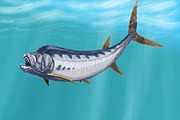 |
|||
Bananogmius Bananogmius Bananogmius is an extinct genus of bony fish that lived in what is today Kansas during the Late Cretaceous. It lived in the Western Interior Seaway, which split North America in two during the Late Cretaceous.-In popular culture:... |
B. crieleyi |
A tselfatiform |
||||
Cimolichthys Cimolichthys Cimolichthys is an extinct genus of predatory salmonid fish from the Late Cretaceous of North America and Europe.... |
C. nepaholica |
A salmoniform Salmonidae Salmonidae is a family of ray-finned fish, the only living family currently placed in the order Salmoniformes. It includes salmon, trout, chars, freshwater whitefishes and graylings... |
||||
Enchodus Enchodus Enchodus is an extinct genus of bony fish. It flourished during the Upper Cretaceous and was small to medium in size. One of the genus' most notable attributes are the large "fangs" at the front of the upper and lower jaws and on the palatine bones, leading to its misleading nickname among fossil... |
E. petrosus |
Salmoniforms Salmonidae Salmonidae is a family of ray-finned fish, the only living family currently placed in the order Salmoniformes. It includes salmon, trout, chars, freshwater whitefishes and graylings... |
||||
E. saevus |
||||||
Hoplopteryx Hoplopteryx Hoplopteryx is an extinct genus of fish from the Cretaceous.-External links:* in the Paleobiology Database... |
Hoplopteryx sp. |
A beryciform Beryciformes Beryciformes is an order of ray-finned fishes. This is a very poorly understood group of 16 families, 57 genera, and about 219 species. Some people believe that it is probably an artificial assemblage of unrelated taxa that are thrown together for convenience only; there are no convincing... |
||||
Ichthyodectes Ichthyodectes Ichthyodectes ctenodon was a 4-metre long ichthyodectid. It lived in the Western Interior Seaway during the late Cretaceous. It was closely related to the 4 to 6 metre long Xiphactinus audax, and the 2-metre long Gillicus arcuatus, and like other ichthyodectids, I. ctenodon is presumed to have... |
I. ctenodon |
An ichthyodectiform |
||||
Moorevillia Moorevillia Moorevillia is an extinct genus of prehistoric bony fish that lived during the Campanian.-See also:* Prehistoric fish* List of prehistoric bony fish... |
M. hardi |
An elopiform Elopiformes Elopiformes is the order of ray-finned fish that includes the tarpons, tenpounders, and ladyfish, as well as a number of extinct types. They have a long fossil record, easily distinguished from other fishes by the presence of an additional set of bones in the throat.They are related to the order... |
||||
Pachyrhizodus Pachyrhizodus Pachyrhizodus is an extinct genus of bony fish.-Further reading:*Wildlife of Gondwana: Dinosaurs and Other Vertebrates from the Ancient Supercontinent by Pat Vickers Rich, Thomas Hewitt Rich, Francesco Coffa, and Steven Morton... |
P. caninus |
An elopiform Elopiformes Elopiformes is the order of ray-finned fish that includes the tarpons, tenpounders, and ladyfish, as well as a number of extinct types. They have a long fossil record, easily distinguished from other fishes by the presence of an additional set of bones in the throat.They are related to the order... |
||||
Saurodon Saurodon Saurodon is an extinct genus of Ichthyodectid fish from the Cretaceous.Saurodon leanus is known to occur as early as the late Coniacian through the Santonian, in the Late Cretaceous.- Species :... |
S. leanus |
An ichthyodectiform |
||||
Stratodus Stratodus Stratodus is a genus of prehistoric fish. This sleek fish has an upper jaw filled with multiple layers of tiny teeth.-References:*http://paleodb.org/cgi-bin/bridge.pl?action=checkTaxonInfo&taxon_no=35586&is_real_user=1... |
S. apicalis |
An alepisauriform Alepisauriformes Alepisauriformes is an order of fish described by Regan in 1911. The only living genus of this order is Alepisaurus . A Russian fossil of Apateodus dates back around 112 million years.... |
||||
Xiphactinus Xiphactinus Xiphactinus was a large, 4.5 to 6 m long predatory bony fish that lived in the Western Interior Sea, over what is now the middle of North America, during the Late Cretaceous. When alive, the fish would have resembled a gargantuan, fanged tarpon... |
X. audax |
An ichthyodectiform |
||||
Dinosaurs
Indeterminate hadrosaurid, nodosaurid, dinosaur egg, and ornithomimmosaur fossils are known from Moorville Chalk outcrops in Alabama.| Dinosaur Dinosaur Dinosaurs are a diverse group of animals of the clade and superorder Dinosauria. They were the dominant terrestrial vertebrates for over 160 million years, from the late Triassic period until the end of the Cretaceous , when the Cretaceous–Paleogene extinction event led to the extinction of... s reported from the Mooreville Chalk Formation |
||||||
|---|---|---|---|---|---|---|
| Genus | Species | Location | Stratigraphic position | Material | Notes | Images |
Angelinornis |
A. antecessor |
A. antecessor was originally described as Plegadornis antecessor, but the generic name Plegadornis was preoccupied, so the genus Angelinornis was erected to contain the species. It was later demonstrated that Angelinornis was a junior synonym of Ichthyornis Ichthyornis Ichthyornis is a genus of toothed seabirds from the Late Cretaceous of North America. Its fossil remains are known from the chalks of Alberta, Alabama, Kansas, New Mexico, Saskatchewan, and Texas, in strata that were laid down in the Western Interior Seaway during the Turonian-Campanian ages,... , although the new combination I. antecessor was held to be valid for a while following the sinking of Angelinornis into Ichthtyornis. Later the species would later be considered a junior synonym of the Ichthyornis type species, I. dispar. |
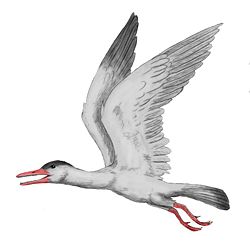 |
|||
Halimornis Halimornis Halimornis was an enantiornithine bird. It lived during the Late Cretaceous about 80 mya and is known from fossils found in the Mooreville Chalk Formation in Greene County, Alabama... |
H. thompsoni |
|
"Vertebrae and limb elements." |
An enantiornithine |
||
Ichthyornis Ichthyornis Ichthyornis is a genus of toothed seabirds from the Late Cretaceous of North America. Its fossil remains are known from the chalks of Alberta, Alabama, Kansas, New Mexico, Saskatchewan, and Texas, in strata that were laid down in the Western Interior Seaway during the Turonian-Campanian ages,... |
I. antecessor |
The species I. antecessor was erected after the genus previously containing the species, Angelinornis, was shown to be a junior synonym for Ichthyornis Ichthyornis Ichthyornis is a genus of toothed seabirds from the Late Cretaceous of North America. Its fossil remains are known from the chalks of Alberta, Alabama, Kansas, New Mexico, Saskatchewan, and Texas, in strata that were laid down in the Western Interior Seaway during the Turonian-Campanian ages,... . Later I. antecessor itself was shown to be a junior synonym of the Ichthyornis Ichthyornis Ichthyornis is a genus of toothed seabirds from the Late Cretaceous of North America. Its fossil remains are known from the chalks of Alberta, Alabama, Kansas, New Mexico, Saskatchewan, and Texas, in strata that were laid down in the Western Interior Seaway during the Turonian-Campanian ages,... type species, I. dispar |
||||
I. dispar |
|
An ichthyornithine. |
||||
Lophorhothon Lophorhothon Lophorhothon is a genus of hadrosauroid dinosaur from the Late Cretaceous, the first genus of dinosaur discovered in Alabama.-Discovery and naming:... |
L. atopus |
|
A hadrosaurid Hadrosaurid Hadrosaurids or duck-billed dinosaurs are members of the family Hadrosauridae, and include ornithopods such as Edmontosaurus and Parasaurolophus. They were common herbivores in the Upper Cretaceous Period of what are now Asia, Europe and North America. They are descendants of the Upper... . |
|||
Plegadornis |
P. antecessor |
The name Plegadornis antecessor was applied to a fossil believed to represent a new bird species, but the generic name Plegadornis was preoccupied, so the genus Angelinornis was erected to contain the "new" species. It was later demonstrated that Angelinornis was a junior synonym of Ichthyornis Ichthyornis Ichthyornis is a genus of toothed seabirds from the Late Cretaceous of North America. Its fossil remains are known from the chalks of Alberta, Alabama, Kansas, New Mexico, Saskatchewan, and Texas, in strata that were laid down in the Western Interior Seaway during the Turonian-Campanian ages,... , although the new combination I. antecessor was held to be valid for a while following the sinking of Angelinornis into Ichthtyornis. Later the species would later be considered a junior synonym of the Ichthyornis type species, I. dispar. |
||||
Mosasaurs
| Mosasaurs of the Mooreville Chalk Formation | ||||||
|---|---|---|---|---|---|---|
| Genus | Species | Location | Stratigraphic position | Abundance | Notes | Images |
Clidastes Clidastes Clidastes is an extinct genus of mosasaur lizard from marine environments of the Late Cretaceous.Clidastes was an agile and fast swimmer that cruised the surface or shallow waters hunting for fish, flying reptiles and anything that got too close.- Appearance :Clidastes was the smallest of the... |
C. liodontus |
Mosasaurines |
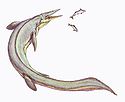 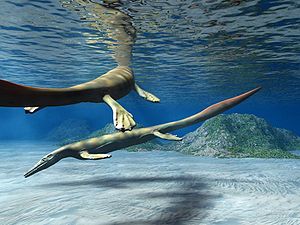  |
|||
C. moorevillensis |
||||||
C. propython |
||||||
Eonatator Eonatator Eonatator is a genus of halisaurine mosasaur from the Upper Cretaceous of North America and Europe. Originally, this taxon was included within Halisaurus, but was placed in its own genus... |
E. sternbergii |
A halisaurine E. sternbergii was formerly classified as Halisaurus sternbergii Halisaurus Halisaurus is an extinct genus of marine lizard belonging to the mosasaur family. With a length of 3–4 m , it was small compared to most other mosasaurs. It was named by Othniel Charles Marsh in 1869, but renamed Baptosaurus by Marsh in 1870, who thought the name was already in use by a fish... |
||||
Globidens Globidens Globidens is an extinct genus of mosasaur lizard.Globidens alabamaensis was first described by Gilmore . A second species was described by Russell . The third North American species Globidens ("Globe teeth") is an extinct genus of mosasaur lizard.Globidens alabamaensis was first described by... |
G. alabamaensis |
A mosasaurine |
||||
Mosasaurus Mosasaurus Mosasaurus is a genus of mosasaur, carnivorous, aquatic lizards, somewhat resembling flippered crocodiles, with elongated heavy jaws. The genus existed during the Maastrichtian age of the Cretaceous period , around 70-65 millions years ago in the area of modern Western Europe and North America... |
M. missouriensis |
A mosasaurine |
||||
Platecarpus Platecarpus Platecarpus is an extinct genus of aquatic lizard belonging to the mosasaur family, living around 75 million years ago during the end of the Cretaceous period. Fossils have been found in Belgium and the United States as well as a possible specimen in Africa. Platecarpus probably fed on fish,... |
P. tympaniticus |
A plioplatecarpine |
||||
Prognathodon Prognathodon Prognathodon is an extinct genus of marine reptile belonging to the mosasaur family. It had protective bony rings surrounding its eye sockets, indicating it lived in deep water. its fossil remains have been found in the U.S.A , Canada , Belgium, New Zealand, Morocco and The Netherlands... |
P. rapax |
Mosasaurines |
||||
P. solvayi |
||||||
Selmasaurus Selmasaurus Selmasaurus is a genus of medium-sized plioplatecarpine mosasaur from the Upper Cretaceous Mooreville Chalk Formation of western Alabama... |
S. russelli |
A plioplatecarpine |
||||
Tylosaurus Tylosaurus Tylosaurus was a mosasaur, a large, predatory marine lizard closely related to modern monitor lizards and to snakes.-Paleobiology:... |
T. proriger |
Mosasaurines |
||||
T. zangerli |
||||||
Plesiosaurs
| Plesiosaur Plesiosaur Plesiosauroidea is an extinct clade of carnivorous plesiosaur marine reptiles. Plesiosauroids, are known from the Jurassic and Cretaceous Periods... s of the Mooreville Chalk Formation |
||||||
|---|---|---|---|---|---|---|
| Genus | Species | Location | Stratigraphic position | Abundance | Notes | Images |
Trinacromerum Trinacromerum Trinacromerum is an extinct genus of sauropterygian reptile belonging to the plesiosaur suborder. It lived during the Late Cretaceous period in what is now Kansas. It was 3 meters long. Its teeth show it fed on small fish.... |
Trinacromerum sp. |
Polycotylids |
 |
|||
Pterosaurs
| Pterosaur Pterosaur Pterosaurs were flying reptiles of the clade or order Pterosauria. They existed from the late Triassic to the end of the Cretaceous Period . Pterosaurs are the earliest vertebrates known to have evolved powered flight... s of the Mooreville Chalk Formation |
||||||
|---|---|---|---|---|---|---|
| Genus | Species | Location | Stratigraphic position | Abundance | Notes | Images |
Pteranodon Pteranodon Pteranodon , from the Late Cretaceous geological period of North America in present day Kansas, Alabama, Nebraska, Wyoming, and South Dakota, was one of the largest pterosaur genera and had a maximum wingspan of over... |
Pteranodon sp. |
Pteranodontid Pteranodontidae The Pteranodontidae are a family of large pterosaurs of the Cretaceous Period of North America.The family was named in 1876 by Othniel Charles Marsh.... s. |
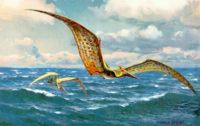 |
|||
Turtles
| Turtle Turtle Turtles are reptiles of the order Testudines , characterised by a special bony or cartilaginous shell developed from their ribs that acts as a shield... s of the Mooreville Chalk Formation |
||||||
|---|---|---|---|---|---|---|
| Genus | Species | Location | Stratigraphic position | Abundance | Notes | Images |
Bothremys |
B. barberi |
A pelomedusid Pelomedusidae Pelomedusidae is a family of freshwater turtles, native to eastern and southern Africa. They range in size from to in shell length, and are generally roundish in shape... . |
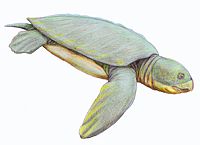 |
|||
Corsochelys Corsochelys Corsochelys is an extinct genus of sea turtle that lived in the Late Cretaceous . Zangerl named the type species , based upon remains found in Alabama within the Mooreville Chalk Formation .-Description:Corsochelys is a basal dermochelyid... |
C. haliniches |
A dermochelyid Dermochelyidae Dermochelyidae is a family of turtles which has eight extinct and one extant genera.-Classification of known genera:*Subfamily Desmatochelyinae** Corochelys ** Desmatochelys *Subfamily Allopleuroninae ** Allopleuron ** Eosphargis... . |
||||
Protostega Protostega Protostega gigas is an extinct species of marine turtle. It was first collected from the Smoky Hill Chalk of western Kansas in 1871, and named by E.D. Cope... |
P. gigas |
A protostegid Protostegidae Protostegidae is a family of extinct marine turtles that lived during the Mesozoic Era. The family includes some of the largest sea turtles that ever existed. The largest, Archelon, had a head a meter long... . |
||||
Toxochelys Toxochelys Toxochelys is an extinct genus of sea turtle from the Cretaceous period. It is the most commonly found fossilized turtle species in the Smoky Hill Chalk, in western Kansas. Toxochelys was about 2 m in length... |
T. moorevillensis |
A toxochelyid. |
||||

